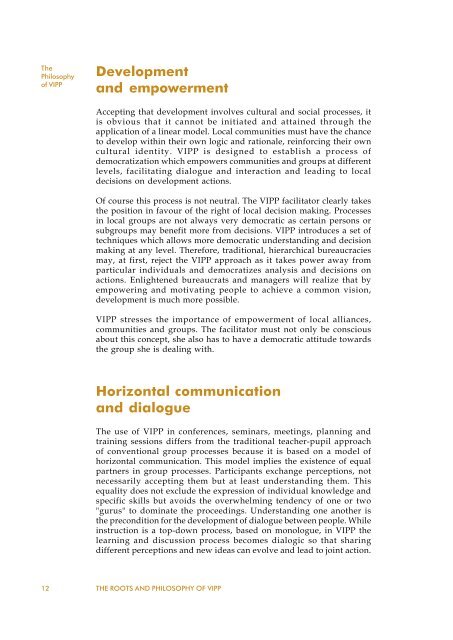VIPP_Unicef
VIPP_Unicef
VIPP_Unicef
Create successful ePaper yourself
Turn your PDF publications into a flip-book with our unique Google optimized e-Paper software.
The<br />
Philosophy<br />
of <strong>VIPP</strong><br />
12<br />
Development<br />
and empowerment<br />
Accepting that development involves cultural and social processes, it<br />
is obvious that it cannot be initiated and attained through the<br />
application of a linear model. Local communities must have the chance<br />
to develop within their own logic and rationale, reinforcing their own<br />
cultural identity. <strong>VIPP</strong> is designed to establish a process of<br />
democratization which empowers communities and groups at different<br />
levels, facilitating dialogue and interaction and leading to local<br />
decisions on development actions.<br />
Of course this process is not neutral. The <strong>VIPP</strong> facilitator clearly takes<br />
the position in favour of the right of local decision making. Processes<br />
in local groups are not always very democratic as certain persons or<br />
subgroups may benefit more from decisions. <strong>VIPP</strong> introduces a set of<br />
techniques which allows more democratic understanding and decision<br />
making at any level. Therefore, traditional, hierarchical bureaucracies<br />
may, at first, reject the <strong>VIPP</strong> approach as it takes power away from<br />
particular individuals and democratizes analysis and decisions on<br />
actions. Enlightened bureaucrats and managers will realize that by<br />
empowering and motivating people to achieve a common vision,<br />
development is much more possible.<br />
<strong>VIPP</strong> stresses the importance of empowerment of local alliances,<br />
communities and groups. The facilitator must not only be conscious<br />
about this concept, she also has to have a democratic attitude towards<br />
the group she is dealing with.<br />
Horizontal communication<br />
and dialogue<br />
The use of <strong>VIPP</strong> in conferences, seminars, meetings, planning and<br />
training sessions differs from the traditional teacher-pupil approach<br />
of conventional group processes because it is based on a model of<br />
horizontal communication. This model implies the existence of equal<br />
partners in group processes. Participants exchange perceptions, not<br />
necessarily accepting them but at least understanding them. This<br />
equality does not exclude the expression of individual knowledge and<br />
specific skills but avoids the overwhelming tendency of one or two<br />
"gurus" to dominate the proceedings. Understanding one another is<br />
the precondition for the development of dialogue between people. While<br />
instruction is a top-down process, based on monologue, in <strong>VIPP</strong> the<br />
learning and discussion process becomes dialogic so that sharing<br />
different perceptions and new ideas can evolve and lead to joint action.<br />
THE ROOTS AND PHILOSOPHY OF <strong>VIPP</strong>


